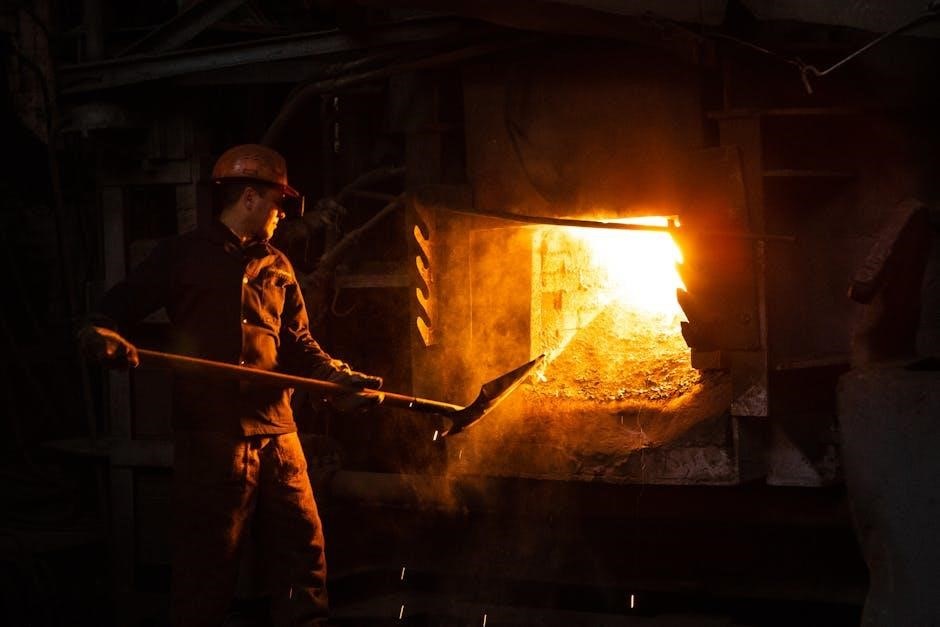Furnace sizing is crucial for efficient heating and energy savings. Proper sizing ensures your home stays comfortable while avoiding excessive energy costs. Learn how to calculate BTUs, consider climate, insulation, and more to choose the right furnace for your space.
Why Proper Furnace Sizing Matters
Proper furnace sizing ensures optimal heating efficiency, reducing energy bills and extending equipment lifespan. An oversized furnace wastes energy, while an undersized one struggles to heat adequately. Correct sizing balances comfort and cost, preventing overheating or insufficient warmth. It also maintains indoor air quality and humidity levels, enhancing overall home comfort. Improper sizing can lead to premature wear and higher maintenance costs. Accurate sizing tailors the furnace to your home’s specific needs, ensuring reliable performance during extreme temperatures. Consulting a professional guarantees the right fit, avoiding long-term issues and ensuring your system runs efficiently year-round.
Overview of Furnace Sizing Basics
Furnace sizing involves determining the correct BTU (British Thermal Unit) output needed for your home. BTUs measure a furnace’s heating capacity. The process considers factors like square footage, climate, insulation, and window efficiency. A general rule of thumb is 20-40 BTUs per square foot, but this varies. Tools like online calculators and professional assessments help estimate requirements. Proper sizing ensures efficient heating and energy savings. Understanding these basics helps homeowners make informed decisions when selecting a furnace. Accurate sizing is key to a comfortable and cost-effective heating system. It’s essential to avoid oversizing or undersizing for optimal performance.

Key Factors Influencing Furnace Size
Climate, geographic location, home insulation, window efficiency, square footage, and ductwork are essential factors. Each influences BTU requirements and system efficiency, ensuring optimal heating performance.

Climate and Geographic Location
Climate and geographic location significantly influence furnace sizing. Homes in colder regions require higher BTU capacities to combat harsh winters, while warmer areas need less heating power. For instance, areas with freezing temperatures may require 30-60 BTUs per square foot, whereas milder climates might need only 20-30 BTUs. Local temperature extremes, average outdoor temperatures, and regional heating demands are critical factors. A furnace sized for a cold climate in the north would be oversized for a southern home, leading to inefficiency. Understanding your area’s climate helps determine the optimal furnace size for consistent comfort and energy efficiency.
Home Insulation Quality
Home insulation quality plays a vital role in determining the right furnace size. Well-insulated homes retain heat better, reducing the load on the heating system. This allows for a smaller furnace, lower energy bills, and increased efficiency. Poor insulation, however, forces the furnace to work harder, potentially requiring a larger unit. Insulation levels in walls, floors, ceilings, and windows must be considered. A well-sealed home might use the lower end of BTU recommendations, while drafty spaces may need higher capacities to maintain comfort. Proper insulation ensures your furnace operates efficiently and effectively year-round.
Window Age and Efficiency
Window age and efficiency significantly impact furnace sizing. Older, single-pane windows allow more heat loss, increasing the furnace’s workload. Energy-efficient, double- or triple-pane windows reduce heat loss, enabling a smaller furnace. Assessing window quality helps determine the necessary BTU output. Modern windows with low-e coatings or gas fills enhance insulation, lowering heating demands. Replacing outdated windows can reduce furnace size requirements, saving energy and costs. Window efficiency directly influences home heating needs, making it a key factor in accurate furnace sizing calculations.
Home Square Footage

Home square footage is a key factor in determining furnace size. As a general rule, furnace sizing begins with calculating BTUs based on the home’s size. A common guideline is 20-40 BTUs per square foot, depending on climate and insulation. For example, a 1,500-square-foot home might require 30,000 to 60,000 BTUs. However, this varies with insulation quality, window efficiency, and local temperatures. Accurate square footage measurement is essential for proper furnace sizing, ensuring efficient heating without oversizing or undersizing the system. Use online calculators or consult professionals for precise calculations tailored to your home’s specific needs.
Ductwork and Ventilation System
A well-designed ductwork and ventilation system is vital for furnace efficiency. Properly sized ducts ensure even heat distribution and prevent energy loss. Leaks or poorly insulated ducts can reduce system performance, increasing energy bills. The ventilation system’s capacity must match the furnace’s output to maintain optimal airflow. Upgrading or sealing ductwork can enhance efficiency, especially in older homes. A professional HVAC assessment can identify ductwork issues and recommend improvements, ensuring the furnace operates effectively and safely. Proper ventilation also improves indoor air quality and overall comfort.

Calculating Furnace Size
Calculating furnace size involves evaluating your home’s climate, insulation, window efficiency, and square footage to determine the optimal BTU output for consistent heating and energy efficiency.
Using Square Footage for BTU Calculation
Using square footage for BTU calculation is a common method to estimate furnace size. A general rule of thumb is 20-60 BTUs per square foot, depending on climate. For example, a 1,500-square-foot home in a moderate climate might require 30,000-60,000 BTUs, while a larger or poorly insulated home may need more. Insulation quality and window efficiency also influence the calculation. By multiplying your home’s square footage by the BTU range for your area, you can determine the appropriate furnace size. This method provides a baseline, but climate and home specifics should be considered for accuracy.
Understanding BTU Ratings
BTU (British Thermal Unit) ratings measure a furnace’s heating capacity. Higher BTUs indicate more heat output. For sizing, BTUs are calculated based on your home’s square footage and climate. A general range is 20-60 BTUs per square foot, varying by location. For instance, a 1,500-square-foot home in a colder area might need 60,000 BTUs, while a smaller home in a warmer climate could require 30,000 BTUs. Accurate BTU ratings ensure efficient heating without energy waste. Properly matching BTU ratings to your home’s needs is essential for optimal performance and comfort. This ensures your furnace operates efficiently year-round.
Manual J Heat Load Calculation
A Manual J heat load calculation is a detailed analysis to determine your home’s precise heating requirements. It considers factors like climate, insulation quality, window efficiency, and ductwork to ensure accurate furnace sizing. This method accounts for heat loss and gain, providing a tailored recommendation for your HVAC system. Manual J is more precise than basic BTU estimates, as it evaluates specific conditions in your home. Conducted by professionals, it uses specialized software to calculate exact heating loads, ensuring your furnace operates efficiently and maintains consistent comfort. This comprehensive approach is essential for optimal furnace performance and energy savings.

Tools for Determining Furnace Size
Online furnace size calculators provide quick BTU estimates based on square footage and climate. Professional HVAC assessments offer detailed evaluations for precise furnace sizing needs.

Online Furnace Size Calculators
Online furnace size calculators are handy tools for estimating BTU requirements based on home size, location, and window efficiency. They provide quick, free estimates for homeowners. Simply input your home’s square footage, climate zone, and window age to get a recommended BTU range. These calculators are useful for initial research but may not account for all factors like insulation quality or ductwork efficiency. For precise sizing, pair calculator results with professional HVAC assessments to ensure accuracy and optimal furnace performance tailored to your home’s unique needs.
Professional HVAC Assessment
A professional HVAC assessment provides accurate furnace sizing by evaluating your home’s unique conditions. Experts consider factors like insulation, ductwork, window efficiency, and local climate to recommend the ideal BTU rating. This detailed evaluation ensures optimal performance, energy efficiency, and comfort. Unlike online calculators, a professional assessment offers personalized insights, avoiding common sizing mistakes. Investing in an HVAC expert’s opinion guarantees a furnace that meets your home’s specific heating needs, saving energy and enhancing overall system reliability and longevity. It’s a crucial step for homeowners seeking a tailored heating solution.

Common Mistakes in Furnace Sizing
Oversizing or undersizing furnaces is a frequent error, leading to inefficiency and discomfort. Ignoring AFUE ratings and not accounting for ductwork or insulation further compounds these issues, reducing system performance.
Oversizing the Furnace
Oversizing a furnace is a common mistake that leads to energy inefficiency and higher costs. A furnace that is too large for the space will cycle on and off frequently, known as short cycling, which reduces its lifespan and increases energy bills. This also causes uneven heating, as the furnace doesn’t run long enough to maintain consistent temperatures. Additionally, an oversized furnace may struggle to maintain proper humidity levels, leading to discomfort. Always consult a professional to ensure your furnace is appropriately sized for your home’s specific needs to avoid these issues.
Undersizing the Furnace
Undersizing a furnace can lead to insufficient heating and increased energy consumption. A furnace that is too small for the space will run continuously, struggling to maintain desired temperatures. This constant operation increases energy bills and reduces the furnace’s lifespan. Additionally, an undersized furnace may fail to heat all areas evenly, resulting in cold spots. Proper sizing ensures efficient heating and consistent comfort, making it essential to avoid undersizing. Always consider factors like climate, insulation, and square footage when selecting a furnace to ensure it meets your home’s specific heating needs effectively.
Ignoring AFUE and Efficiency Ratings
Ignoring AFUE (Annual Fuel Utilization Efficiency) and efficiency ratings can lead to higher energy costs and reduced comfort. AFUE measures how efficiently a furnace converts fuel to heat. A higher AFUE means more heat is produced with less fuel, lowering energy bills. Overlooking these ratings can result in choosing a furnace that is inefficient for your home’s needs. Always compare AFUE ratings and consider your climate to ensure optimal performance and savings. Efficient furnaces also last longer and require less maintenance, making them a wise long-term investment for homeowners.

Selecting the Right Furnace
Selecting the right furnace involves balancing size, efficiency, and fuel type. Consider your home’s heating needs, budget, and climate to make an informed decision for optimal comfort and savings.
Choosing Between Gas, Oil, or Electric Furnaces
When selecting a furnace, consider fuel type: gas furnaces offer high efficiency and quick heating, while oil furnaces are ideal for areas without natural gas access. Electric furnaces are environmentally friendly and cost-effective but may have higher operating costs in colder climates. Each option has unique benefits, so evaluate your energy needs, budget, and location to decide which furnace type aligns best with your home’s requirements for reliable and efficient heating.
Importance of AFUE Ratings
AFUE (Annual Fuel Utilization Efficiency) ratings measure a furnace’s energy efficiency, indicating the percentage of fuel converted into usable heat. Higher AFUE ratings mean greater efficiency, lower energy bills, and reduced environmental impact. For example, a 90% AFUE furnace uses 90% of its fuel for heating and loses 10% through combustion. When selecting a furnace, prioritize higher AFUE ratings to ensure optimal performance and cost savings over time, especially in colder climates where heating demands are higher.
Additional Features to Consider
Beyond basic functionality, modern furnaces offer features that enhance comfort and efficiency. Look for variable-capacity operation, which adjusts heat output to match demand, reducing energy waste. Two-stage burners provide consistent temperatures and quieter operation. Programmable thermostats and smart home integration allow remote control and energy monitoring. Air purification systems improve indoor air quality, while humidity control maintains a comfortable environment. Some furnaces also offer advanced diagnostics for maintenance alerts. Consider warranties and reliability when selecting your furnace to ensure long-term performance and peace of mind.
